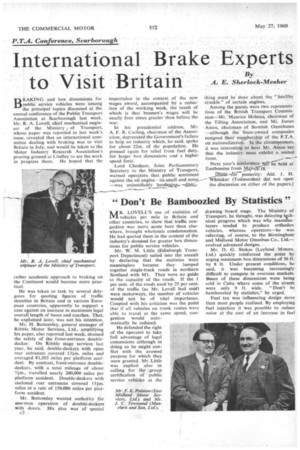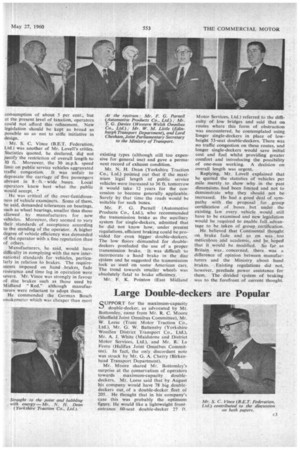"Don't Be Bamboozled By Statistics"
Page 52

Page 53

If you've noticed an error in this article please click here to report it so we can fix it.
lkif R. LOVELL'S use of statistics of
vehicles per mile in Britain and other countries, to show that traffic congestion was more acute here than elsewhere, brought wholesale condemnation. He had quoted them in the context of the industry's demand for greater box dimensions for public service vehicles.
Mr. W. M. Little (Edinburgh Transport Department) sailed into the assault by declaring that the statistics were meaningless because they lumped together single-track roads in northern Scotland with Ml. They were no guide to the capacity of the roads. If the I per cent. of the roads used by 25 per cent. of the traffic (as Mr. Lovell had said) were motorways, the number of vehicles would not be of vital importance. Coupled with his criticism was the point that if all vehicles on trunk routes were able to travel at the same speed, congestion would automatically be reduced.
He defended the right of the operator to take full advantage of legal concessions although in doing so he might conflict with the avowed purpose for which they were granted. Mr. Little was explicit also in calling for the group certification of public service vehicles at the drawing board stage. The Ministry of Transport, he thought, was delaying tichnical progress which was why manufacturers tended to produce orthodox vehicles, whereas operators—he was referring, of course, to the Birmingham and Midland Motor Omnibus Co., Ltd.— evolved advanced designs.
Mr. D. G. Stokes (Leyland Motors, Ltd.) quickly reinforced the point by urging maximum box dimensions of 36 ft. by 8 ft. Under present conditions, he said, it was becoming increasingly difficult to compete in overseas markets. Buses of these dimensions were being sold in Cuba where some of the streets were only 9 ft. wide. "Don't be bamboozled by statistics," he urged.
Fuel tax was influencing design more than most people realized. By employing fuel injection it was possible to reduce noise at the cost of an increase in fuel consumption of about 5 per cent., but at the present level of taxation, operators could not afford this refinement. New legislation should be kept as broad as possible so as not to stifle initiative in design.
Mr. S. C. Vince (B.E.T. Federation, Ltd.) was another of Mr. Lovell's critics. Statistics quoted, he declared, did not justify the restriction of overall length 40 30 ft. Moreover, the 30 m.p.h. speed limit on public service vehicles aggravated traffic congestion. It was unfair to deprecate the carriage of five passengers abreast in 8 -.ft. wide buses. Local operators knew best what the public would accept.
He was critical of the over-fastidiousness of vehicle examiners. Son-le of them, he said, demanded tolerances on bearings, such as wheel hearings, smaller than those allowed by manufacturers for new vehicles. Moreover, they seemed to vary their standards of acceptance according to the standing of the operator. A higher degree of vehicle efficiency was demanded of the operator with a fine reputation than of others.
Manufacturers, he said, would have difficulty in complying with the new international standards for vehicles, particularly in relation to brakes. The requirements imposed on hand• brakes, fade resistance and time lag in operation were severe. Mr. Vince was strongly in favour of disc brakes such as those used by Midland "Red,"although manufacturers were reluctant to adopt them.
He commended the German Bosch smokemeter which was cheaper than most existing types (although still too expensive for general use) and gave a permanent record of exhaust condition.
Mr. N. H. Dean (Yorkshire Traction Co., Ltd.) pointed out that if the maximum legal length of public service vehicles were increased to 36 ft. tomorrow it would take 12 years for the concession to become generally applicable.Surely by that time the roads would be suitable for such buses.
Mr. F. G. Parnell (Automotive Products Co., Ltd.), who recommended the transmission brake as the auxiliary system for single-deckers, admitted that he did not know how, under present regulations, efficient braking could be provided for even bigger double-deckers. The low floors demanded for doubledeckers precluded the use of a proper transmission brake. It was difficult to incorporate a hand brake in the disc system and he suggested the transmission lock as used on some American cars. The trend towards smaller wheels was absolutely fatal to brake efficiency.
Mr. F. K. Pointon (East Midland Motor Services. Ltd.) referred to the difficulty of low bridges and said that on routes where this form of obstruction was encountered, he contemplated using ronger single-deckers in place of lowheight 53-seat double-deckers. There was no traffic congestion on these routes, and longer single-deckers would save initial cost and fuel whilst providing greater comfort and introducing the possibility of one-man working. A decision on overall length was urgent.
Replying, Mr. Lovell explained that he quoted the statistics of vehicles per mile merely to show why in the past dimensions had been limited and not to demonstrate why they should not be increased. He had a good deal of sympathy with the proposal . for group certification of buses but under the existing law every vehicle .would still have to be examined and new legislation would be required to enable full, advantage to be taken of group certification.
He believed that Continental thought on brake fade and so on was too meticulousand academic, and he hoped that it would be. modified. So far as Britain was, concerned, there was a difference of opinion between manufacturers and the Ministry about hand brakes. Existing regulations did not, however, preclude power assistance for them. The divided system of braking was to the forefront of current thought.
















































































































